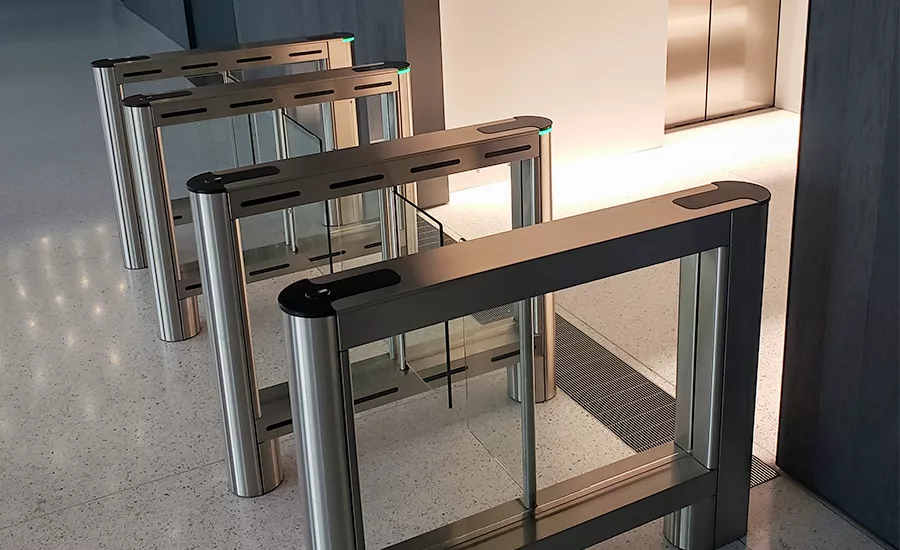Achieving accessibility and security with turnstiles

In 2009, a man born without arms claimed a Tampa, Fla. Bank would not let him cash a check because he could not provide a thumbprint. Although the check was written by his wife, who had an account at that branch, the bank had a no-exception policy of requiring a thumbprint if checks needed to be cashed without having an existing account. And, while he was offered two solutions – either open an account or get his wife – they were not convenient nor accessible.
“Accessible” means a person with a disability is afforded the opportunity to acquire the same information, engage in the same interactions, and enjoy the same services as a person without a disability in an equally effective and equally integrated manner, with substantially equivalent ease of use.
But, accessibility in security has not been a critical focus for the security industry. And, security should never be an oversight. Neither should accessibility.
So how can organizations provide access to people with disabilities? A key improvement organizations and facilities can embark on is entrance and access control. Access control is not only paramount to building safe and accessible access for those who may have difficulty with traditional security systems, but also to stay compliant with codes such as the 1990 Americans with Disabilities Act (ADA), which was recently amended in 2010. Buildings that are open or offer services to the general public are called “places of public accommodation” by the ADA, and must be fully accessible to people with disabilities if built or designed after January 26, 1992. If built before this date, places of public accommodation must undertake “readily achievable barrier removal,” which consists of activities that can be easily carried out without much difficulty or expense.
Per ADA guidance, door hardware must be compliant, and door controls and reader heights must be accessible. Accessible doors should provide at least 32 inches of clear width; thresholds cannot be higher than 1/2 inch at accessible doors, including sliding doors.
Because canes, wheelchairs and other mobility devices can snag on door surfaces, the push side of new swinging doors and gates that are within 10 inches of the finish floor or ground must have smooth surfaces. The smooth surface should extend the full width of the door.
Turnstiles must also include gates to truly be accessible. Whether you’re looking to install turnstiles for the first time, or upgrade older lanes, ensuring that you’re meeting the accessibility requirements of your facility is a top priority.
According to the ADA, revolving doors or turnstiles must not be the only means of “passage at an accessible entrance or along an accessible route. An accessible gate or door shall be provided adjacent to the turnstile or revolving door and shall be designed as to facilitate the same use pattern.”
These doors must be able to fit a wheelchair through the opening. And while several turnstile models provide ADA-compliant lane widths, the need for even wider lanes has not been equally addressed.
However, recent technology innovation can now offer turnstiles that feature even wider lanes to accommodate typical pedestrian traffic and extra-wide objects, such as wheelchairs or carts, which optimize space use by eliminating the need for a separate gate and help reduce risks of wheelchairs, canes and other mobility devices snagging on door surfaces.
Moreover, organizations can achieve accessibility without compromising security. Wider width lanes may be tempting to intruders who attempt to tailgate – which is becoming more common as it is primarily hard to monitor within a crowd of people or just high levels of traffic. The barriers close quickly and safely behind users, ensuring that only one person (or those allowed) gain access from each pass authorization and sound an alarm if a response is required.
With new, innovative technology, turnstiles can be equipped with an intelligent infrared matrix, powered by neural network algorithms that can sense who or what is going through a turnstile in real-time. The algorithms help make thousands of calculations per second to determine if entry should be authorized or denied. Overall, this optical technology can help to distinguish between people and objects such as wheelchairs and minimize nuisance alarms, all while maintaining throughput at industry-leading speeds of up to one person per second.
In addition, the turnstiles can be highly customized and suited to high-security environments, as well as integrated into video surveillance or CCTV, elevator dispatch, and various access control systems to ensure safe and secure operations.
The integrations allow for even greater and total access control in any particular facility, keeping track of precisely who is on-site at any given moment, providing a physical and psychological deterrent to prevent intruders and tailgaters while ensuring accessibility for disabled people.
All in all, organizations can help strengthen and support full inclusion and equal opportunity for persons with disabilities by addressing the need for wider entrances.
Looking for a reprint of this article?
From high-res PDFs to custom plaques, order your copy today!





